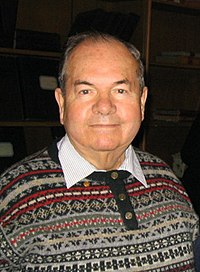Alexei Alexeevich Abrikosov
Alexei Alexeevich Abrikosov (em russo: Алексе́й Алексе́евич Абрико́сов; Moscou, 25 de junho de 1928 – 29 de março de 2017[1]) foi um físico russo.
Recebeu o Nobel de Física de 2003, por contribuições à teoria dos supercondutores e superfluidos.[2]
Foi eleito membro estrangeiro da Royal Society em 2001.[3]
Livros
[editar | editar código-fonte]- Abrikosov, Alexey; Gor'kov, Lev; Dzyaloshinskii, Igor (1975). Methods of Quantum Field Theory in Statistical Physics. London, U.K.: Dover Publications. ISBN 978-0199232727
- Abrikosov, Alexey (1988). Fundamentals of the Theory of Metals. [S.l.]: North Holland. ISBN 978-0444870940
Referências
- ↑ TASS (30 de março de 2017). «Nobel laureate in physics Aleksei Abrikosov dies» (em inglês). Russia Beyond The Headlines. Consultado em 30 de março de 2017
- ↑ «Nobel Prizes and Laureates - Press Release» (em inglês). Nobelprize.org. 7 de outubro de 2003. Consultado em 30 de março de 2017
- ↑ «Portrait of Alexei Alexeyevich Abrikosov». The Royal Society (em inglês). Consultado em 31 de março de 2017
Ligações externas
[editar | editar código-fonte]- Alexei Alexeevich Abrikosov (em inglês) no Mathematics Genealogy Project
- «Perfil no sítio oficial do Nobel de Física 2003» (em inglês)
| Precedido por Raymond Davis Jr., Masatoshi Koshiba e Riccardo Giacconi |
Nobel de Física 2003 com Vitaly Lazarevich Ginzburg e Anthony J. Leggett |
Sucedido por David Gross, Hugh David Politzer e Frank Wilczek |
Text is available under the CC BY-SA 4.0 license; additional terms may apply.
Images, videos and audio are available under their respective licenses.


